
A LIST OF SOME PR FUNCTIONS
• Media relations: gaining editorial coverage
• Issues and risk management
• Crisis management
• CEO reputation management
• Change management
• Internal communications
• Corporate identity and image management
• Managing stakeholder conflicts: NGOs and managing activists
• Corporate social responsibility
• Publications of Annual Reports: corporate reporting
• Corporation reputation management
• Financial and investor relations
• Managing shareholder expectationsExhibition and event management
• Brand building
• Promoting professional services and business to business services
• Managing sponsorship
• Managing relationship with suppliers and distributors
• Building relationships with various buyers
• Media and competitor analysis
• Public affairs and lobbying
• Supporting other elements of the mix
KEY TOOLS FOR PR PRACTITIONERS
• E-mail: press release
• Press briefings/ conferences
• Site, press and VIP visits
• Photography
• Video News Releases (VNRs): digital
• Stunts
• Editorial coverage
• Hospitality events
• Viral campaigns
• Advertorials
• Features
• Webcasting
• Interviews
• Competitions
• Surveys and results of market research
• Case studies
• Corporate literature and publications
• Newsletters and e-zines
• Contract publishing
• Web sites and portals
• Published surveys and reports based on consumer, medical or scientific research

How to Create a PR Plan
Suggestions For An Effective Public Relations Campaign
An institution with a basketball program should consider the following suggestions for
developing a public relations campaign.
Set Goals and Objectives
Determine what is to be accomplished by the public relations campaign and plan to meet these
goals and objectives, such as:
• Increase fan participation/attendance
• Enhance reputation of the sport and its student-athletes
• Generate awareness and enthusiasm for related (but non-competition) activities, such
as youth clinics
• Enhance reputation of the institution/community
Make all public relations actions relevant to meeting the goals and objectives initially
determined.
The public relations campaign should be integrated with the overall marketing plan, which
might include advertising and grassroots or "word-of-mouth," among other practices. It is
important to consider how public relations fits with these other marketing initiatives and
opportunities to maximize their collective impact.
Identify PR Experts Who Can Help
If you're not a PR pro, that's okay. There are numerous experts you can tap, including officials
at your institution. You might even want to form a PR committee to offer and/or help
implement ideas.
Put the Campaign in Writing
Putting the public relations campaign in writing provides a roadmap for implementing activities
leading up to and through the season. It is a guide, but it also helps hold you and your team
accountable for assignments. Also, it is easier to evaluate the impact and success of a plan
that is in writing. Sections for the plan might include:
Objectives
• Target audiences
• Tactics
• Timing
• Measurement
Sample Public Relations Planning Process
Select Target Audiences
Identify key audiences - fans, student-athletes, alumni, the public at large, commercial
entities (current or future) and the like - that should be reached and what will interest
them. These audiences should match those in the overall marketing plan, although PR might
not reach all of them.

Identify Tactics to Communicate to Key Audiences
Communication tactics may include traditional channels, such as media (television, radio,
newspapers and magazines) and Web sites, as well as non-media channels, such as grassroots
or "word-of-mouth" by groups that are naturally enthusiastic about the sport or those who
have had a positive personal experience with it. Tried and true media tactics include:
• News releases - develop a series of news releases that you can distribute to media
prior to and during a season
• Media kit - in addition to a news release, include background on the sport, a biography
on the coaches, student-athletes, etc., and a fact sheet that includes event schedules
and locations
• Guest articles/op-eds - submit articles written by you or the host institution's athletic
director to local papers
• Deskside visits - you or the coach visit local media to create connection and dialogue,
and generate coverage
• Local radio and/or local TV media tours - offer to go on air and talk about the sport
to build excitement
• Public service announcements - develop 30- or 60-second announcements for on-
air personalities to read over the radio
• News conference - gather media for a pre-season look at the team
Don't underestimate the importance and potential impact of non-media
channels. Word-of-mouth can be considerably important in generating enthusiasm for a team,
especially in a campus setting. Non-media channels might include:
• Civic organizations
• Chambers of commerce
• Booster clubs
• Athletic clubs and associations
• Campus and community leaders
Spokesperson: Appoint a knowledgeable spokesperson who can talk with media about the
team and season. This person should be available for news conferences, phone interviews, on-
air interviews, media conference calls, etc.
Implementing the Campaign
Media Relations
Create awareness and interest in the championship by actively promoting the team to the
media.
Media Selection: Compile a list of media contacts that includes radio, television, Web, and
local publications. When selecting media contacts, consider your target audiences and the time
it will take media to cover the team; give yourself ample time to "pitch" your story and the
media outlet ample time to write/publish or air it.
General Tactics:
• Call or e-mail media contacts to introduce yourself. Ask for a phone or in-person
briefing to review/discuss each outlet's interest and plan for covering the season and
how you can be a resource for them. Also ask for details on deadlines, needs,
procedures, including how they prefer to receive news about the team. Listen to their
ideas - and offer your own. For instance:

o A menu of story opportunities regarding student-athletes, anticipated
milestones, records, etc., economic impact, ancillary events that each outlet can
consider for coverage of the team. Your local newspaper might consider
enhancing its coverage throughout the sport's regular season to help educate its
readers about the sport and some of its top collegiate teams and players. This
is especially beneficial for sports that do not receive a lot of media coverage.
o A media kit that summarizes the event, participants, schedule, etc.
o Topics for guest articles or on-air interviews by your designated spokesperson.
o Public service announcements that could be published or aired regarding the
championship.
o News conference schedule.
• Keep each media outlet's goals in mind. If the outlet focuses on men's sports, do not
pitch a women's soccer student-athlete for an interview. If the outlet focuses on
general news, relate your event to the community, (e.g., the economic impact of the
team on the city). Make sure whatever you pitch is news!
• When emailing media, be concise. Shorter is better. Never send attachments. unless
they are requested; embed the copy in the body of your email.
• Do not call to criticize media. Remember how many people, organizations and interest
groups are "battling" for space or airtime.
Press Releases
Press releases help inform media of team-related news and events and can serve as a
summary prior to news conferences in order to help them frame questions. If a press release
contains a great deal of background statistics, then the release is a great tool for journalists
who may need additional information to write a complete story. Follow these guidelines when
preparing a press release:
1. Think of the press release as a quick look at the highlights of the event or
announcement.
2. Never write longer than two pages. Keep sentences short. Keep paragraphs
short.
3. Include the five W's - Who, What, Where, When, Why - in the first or second
paragraph. The rest of the press release covers "How."
4. Spell every name correctly. Names are misspelled in press releases all too
often.
5. Every press release must be typewritten. Leave one-inch margins and double
space.
6. Include the name of the contact person at your organization. In case more information
is needed, include more than one telephone number and an email
address.
7. Do the press release NOW. Old news is useless news. Write it immediately. Email
and/or fax it.
8. Find an angle to make your press release unique.
9. If the media outlet chooses to read your news release on the air, or publish it in the
newspaper, they probably will shorten it by eliminating the information found at the
bottom of the release. So, be sure that vital details are not at the bottom. Rule of
thumb: only the first two paragraphs may make it in the newspaper. Make sure the
most important information is at the top.
10. If photographs accompany a press release, include a brief caption. Include names,
dates and locations for EVERY photograph. Do not write with markers, grease pencils
or other substances that may rub off (or smudge onto other photos).
Post-event Activities
Fax or email results from the event to The Associated Press, Sports Ticker, USA Today and
your local media contacts to increase media coverage of the team.

Preparing for Crisis Communication
Develop a plan for communicating with the media in the event that the sport becomes involved
in some type of public relations crisis (i.e., an accident involving players or spectators, illegal
use of banned substances by players/coaches, etc.) Although the crisis communication plan
may not be utilized, it is better from a public relations standpoint to be proactive rather than
reactive if such a circumstance should occur. The following guidelines are suggested to
prepare for communication with the media during a crisis:
1. Identify the Type of Crisis that Might be Encountered. A crucial step in the
formation of the crisis communication plan is to identify the crisis situations that the
event is most likely to face. Successful event management includes thinking worst-
case scenarios and preparing for them.
2. Develop a Strategy. Identify a broad philosophy for dealing with a crisis if it does
happen. Have a number of focused strategies in place to deal with specific types of
crises. A strategy should be set in advance for management of the crisis and the
primary goal of this strategy should be the protection of participants, spectators and
participating institutions. Having a strategy set in advance will allow for quick action,
which will decrease the time the media is out looking for answers on their own. This
means the public relations staff must have access to high-level university officials and
other key people in the event of a crisis. Frequent media updates must be made
regardless of whether a resolution to the crisis is complete. Also, the most
knowledgeable and appropriate people when providing explanations to the media must
accompany the spokesperson.
3. Form a Committee to Provide Leadership. A small group of key decision makers
who represent the institution and the athletics department should be made familiar with
the crisis communication strategy. This group should be comprised of individuals who
will be at the events and deal with potential crisis situations.
4. Identify a Single Spokesperson. A single spokesperson should be identified to
disseminate pertinent information to the media and the public in the event of a
crisis. The designated spokesperson should always be available to respond to the
media in an attempt to prevent the media from approaching other sources for
information. Ask other staff members to refrain from comment and forward all media
inquiries to the appropriate spokesperson. Brief an alternate spokesperson to take over
in the event that the main spokesperson is called away from the event.
5. Avoid Saying "No Comment." This phrase raises suspicions and could cause
mistrust toward the institution. It is also better to release negative publicity before
someone else does. To allow an outside source to release negative information is to
lose control of the story.
6. Monitor Media Attention. Evaluate how the media is covering the crisis in order to
prepare for additional media inquiries. By keeping up to date and well informed, the
institution will be prepared to better manage the crisis and provide information to the
public (via media) in a timely and straightforward manner. This will help give the
institution an honest and positive image, regardless of the crisis
situation.
7. For additional information regarding principles of communication during a crisis, please
visit:
Principles of Communication During a Crisis
Evaluating the Campaign
Not only should the campaign be evaluated at the end of the season, but also the campaign
should be monitored throughout the entire implementation process to ensure that the goals
and objectives of the plan are being met adequately. A successful plan will be reviewed



















![Bài giảng Thiết kế thông điệp ThS. Lê Anh Phương [chuẩn SEO]](https://cdn.tailieu.vn/images/document/thumbnail/2025/20251231/ocxaodua999/135x160/86921767597063.jpg)






